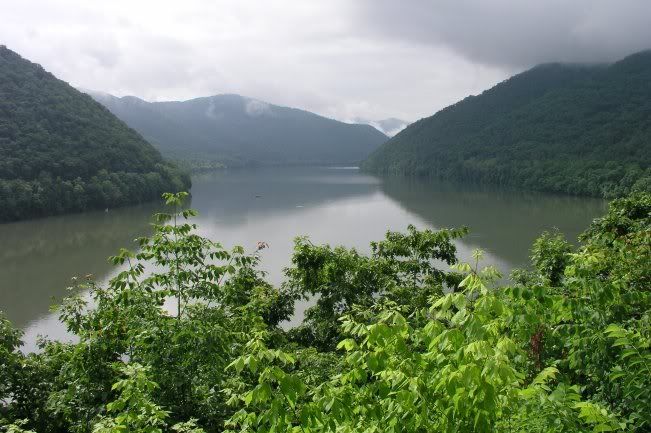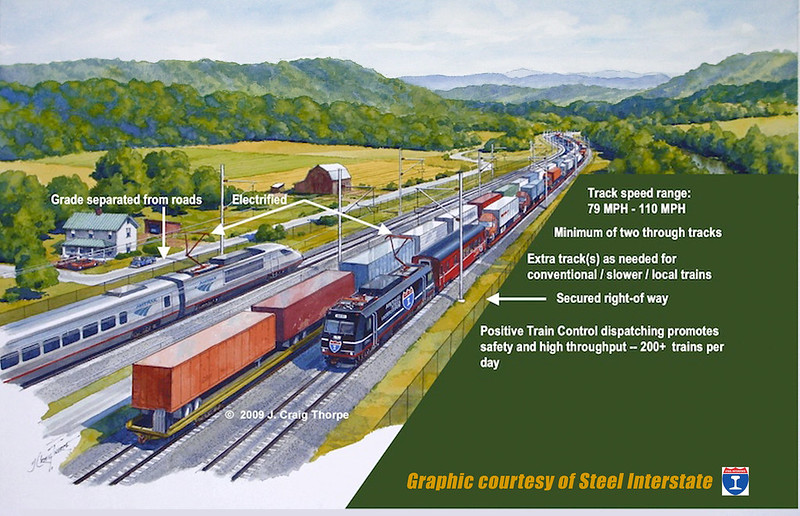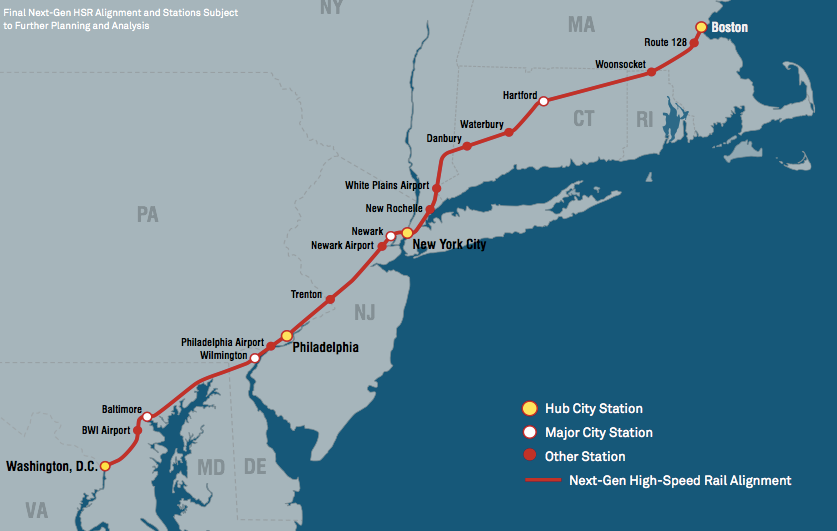Author's posts
Mar 16 2015
Sunday Train: Five Levels of US Intercity Rail Policy
 In Sunday Train last week, I referred to the Bipartisan Majority to Authorize the funding of Amtrak as “Good News”. One commentator in the discussion in one of the crossposts pointed out that the news wasn’t all that particularly good, since continued funding on this basis over the indefinite future will spell serious trouble for the system as a whole.
In Sunday Train last week, I referred to the Bipartisan Majority to Authorize the funding of Amtrak as “Good News”. One commentator in the discussion in one of the crossposts pointed out that the news wasn’t all that particularly good, since continued funding on this basis over the indefinite future will spell serious trouble for the system as a whole.
Now, as I suggested more than once, the “good news” last week certainly was not unqualified good news … that is, to say it was “qualified” good news was already taking on board the bad electoral news for Amtrak in the continued Republican House Majority combined with a new Republican Senate Majority, which opened the door to some of the deep, slashing cuts to Amtrak that some on the Republican side have long hoped to make. So the “qualified good news” was that in going for a total defunding of Amtrak, the radical reactionary wing of the Republican party overplayed its hand, opening the way for a majority of House Republicans, along with basically the entire Democratic caucus, to authorize the continued funding of Amtrak at just about the levels that have been in place over the past four years.
But that was set against the bad news of the INDOT refusing to continue the Hoosier State service on the ground of basically not being allowed to have its cake and eat it too … insisting on acting like the organization putting together a passenger rail service, without being treated as a passenger railway. And so I started thinking about the Hoosier State / Cardinal corridor in the context of, on one hand, the very low bar for “good news” in transport funding with this Congress, versus the tremendous need we have for a massive wave of investment in transport that can be powered by sustainable, renewable energy. And to organize my thinking, I started to sort it out into five levels:
- Level 0: “Very Much Worse”;
- Level 1: “Barely Scraping By”;
- Level 2: “A Basic Skeleton Service Done Right”
- Level 3: “Incremental Growth”
- Level 4: “Aggressive Growth”
More about the five levels … below the fold.
Mar 09 2015
Sunday Train: On Amtrak, I’ve got some good news, and some bad news.
 This last week, there was the surprising start to a headline in the Washington Post that began, “GOP House and White House agree on something” … and that something was: Amtrak funding (and pets on a train).
This last week, there was the surprising start to a headline in the Washington Post that began, “GOP House and White House agree on something” … and that something was: Amtrak funding (and pets on a train).
But its not all good news this week … because if the INDOT has its way, the Hoosier State will be cancelled.
Feb 16 2015
Sunday Train: Future of Rail Technical Symposium, Washington DC. 3 Feb, 2015
 Last week in Washington DC, your Sunday Train correspondent was able to attend the “Future of Rail Symposium” held in Washington DC. The presenters discussed various aspects of building a Steel Interstate corridor, including the Steel Interstate concept, a discussion of electrified rail around the world, why rely on electricity rather than LNG for major backbone corridors, the engineering and economics of electrification in North America, an approach to financing an initial Steel Interstate corridor without requiring new legislation to be passed through our gridlocked Federal government, vehicle and track considerations of the “Rapid Freight” rail component of the Steel Interstate, the labor dimension and the need for a new social contract with Rail Labor, and a final presentation on the “Solutionary Rail” proposal by the Backbone Campaign to establish a Steel Interstate on the BNSF Northern Transcon corridor.
Last week in Washington DC, your Sunday Train correspondent was able to attend the “Future of Rail Symposium” held in Washington DC. The presenters discussed various aspects of building a Steel Interstate corridor, including the Steel Interstate concept, a discussion of electrified rail around the world, why rely on electricity rather than LNG for major backbone corridors, the engineering and economics of electrification in North America, an approach to financing an initial Steel Interstate corridor without requiring new legislation to be passed through our gridlocked Federal government, vehicle and track considerations of the “Rapid Freight” rail component of the Steel Interstate, the labor dimension and the need for a new social contract with Rail Labor, and a final presentation on the “Solutionary Rail” proposal by the Backbone Campaign to establish a Steel Interstate on the BNSF Northern Transcon corridor.
Feb 16 2015
Sunday Train: Future of Rail Technical Symposium, Washington DC. 3 Feb, 2015
 Last week in Washington DC, your Sunday Train correspondent was able to attend the “Future of Rail Symposium” held in Washington DC. The presenters discussed various aspects of building a Steel Interstate corridor, including the Steel Interstate concept, a discussion of electrified rail around the world, why rely on electricity rather than LNG for major backbone corridors, the engineering and economics of electrification in North America, an approach to financing an initial Steel Interstate corridor without requiring new legislation to be passed through our gridlocked Federal government, vehicle and track considerations of the “Rapid Freight” rail component of the Steel Interstate, the labor dimension and the need for a new social contract with Rail Labor, and a final presentation on the “Solutionary Rail” proposal by the Backbone Campaign to establish a Steel Interstate on the BNSF Northern Transcon corridor.
Last week in Washington DC, your Sunday Train correspondent was able to attend the “Future of Rail Symposium” held in Washington DC. The presenters discussed various aspects of building a Steel Interstate corridor, including the Steel Interstate concept, a discussion of electrified rail around the world, why rely on electricity rather than LNG for major backbone corridors, the engineering and economics of electrification in North America, an approach to financing an initial Steel Interstate corridor without requiring new legislation to be passed through our gridlocked Federal government, vehicle and track considerations of the “Rapid Freight” rail component of the Steel Interstate, the labor dimension and the need for a new social contract with Rail Labor, and a final presentation on the “Solutionary Rail” proposal by the Backbone Campaign to establish a Steel Interstate on the BNSF Northern Transcon corridor.
Oct 13 2014
Sunday Train: West Virginia River Runner Rail and the Steel Interstates (from 1 May 2011)
Tonight’s Sunday Train is a repeat from 2011.
Burning the Midnight Oil for Living Energy Independence
 The flashy rail projects are the very HSR projects to build bullet trains serving urban areas with millions of people.
The flashy rail projects are the very HSR projects to build bullet trains serving urban areas with millions of people.
But the role of rail in supporting sustainable extends beyond the bullet train system alone. It may not be critical to the financial success of these bullet trains to provide service to people living in urban areas of 50,000 to 200,000 ~ but its critical to these people to have access to some form of sustainable intercity transport.
Indeed, if we are going to be harvesting wind power, solar power, sustainably coppiced biocoal, geothermal, run of river hydro, and other sustainable resources … we are going to be creating incomes in areas away from the 1m+ cities. We best look after the needs of the people who come to those areas looking for work.
Oct 06 2014
Sunday Train: Cyclists Clamoring for Segregation
 While browsing around reading transport cycling news, I ran across a blog post from the UK from the second half of September: Bas’ Blog: Coming to London: cycle paths fully separated from other traffic (vote!) 23 September 2014:
While browsing around reading transport cycling news, I ran across a blog post from the UK from the second half of September: Bas’ Blog: Coming to London: cycle paths fully separated from other traffic (vote!) 23 September 2014:
This morning in my inbox:
I am writing to let you know that Transport for London, in partnership with the boroughs of Southwark, Camden, Islington and the City of London, would like your views on proposals for a new Cycle Superhighway between Elephant & Castle and King’s Cross.
Yes please! TFL is asking for comments on the plans in a public consultation. More information on the plans can be found here (East-West route) and here (North-South route), you can leave comments here (E-W) and here (N-S).
,,, and when I looked around, stories about segregated “cycle paths” or “cycle tracks” or “cycleways” were not that hard to find. Join me below the fold for a look.
Sep 16 2014
Sunday Train: Reflections on a visit to the East Coast
Cross-posted from The Sunday Train ~ apologies for the jet-lag induced cross-posting delays
Your intrepid sustainable energy and transport reporter was recently required to engage in some official business with an overseas consulate located in New York city, and in order to be able to afford to sit and wait as the wheels of bureaucracy as long as might have been required, obtained lodgings in a relatively cheap motel in New Brunswick and took the NJ Transit Northeast Corridor train back and forth. This week’s Sunday Train is a collection of scattered observations made along the way.
Sep 01 2014
Sunday Train: NEC High Speed Rail for Under $20b (from 15Jul2012)
Sunday Train this week is a re-run from 15 July, 2012
Burning the Midnight Oil for Living Energy Independence
 One of the transit bloggers that I enjoy reading is Alon Levy who blogs his observations on a variety of transit topics at Pedestrian Observations . Following the important California HSR funding vote in the California State Senate and the excitement leading up to it, I thought I’d like to take a look at the proposed Express HSR system for the states of the Northeast Corridor.
One of the transit bloggers that I enjoy reading is Alon Levy who blogs his observations on a variety of transit topics at Pedestrian Observations . Following the important California HSR funding vote in the California State Senate and the excitement leading up to it, I thought I’d like to take a look at the proposed Express HSR system for the states of the Northeast Corridor.
Of the $53b cost of the proposed San Francisco to Los Angeles Express HSR corridor seems hefty ~ and it seems even heftier when it shows the Year of Expenditure headline value of $68b ~ then the proposed Northeast Corridor states Express HSR will seem massive.
However, Alon claims:
Northeast Corridor HSR, 90% Cheaper
…
In contrast with this extravaganza, it is possible to achieve comparable travel times for about one tenth the cost. The important thing is to build the projects with the most benefit measured in travel time reduced or reliability gained per unit of cost, and also share tracks heavily with commuter rail, using timed overtakes to reduce the required amount of multi-tracking.
This sounds like an intriguing possibility … but is it realistic? Or is it wishful thinking? Follow me below the fold, and then let’s discuss it.
Aug 25 2014
Sunday Train: Yet Another Airport Terminal Station Opens on Dallas’s Orange Line
 YAATS (Yet Another Airport Terminal Station) has opened in Dallas for the “orange line” in the Dallas Area Regional Transit light rail system. This is not at the regional airport Love Field, even though the Orange Line runs directly past Love Field, but at the Dallas / Fort Worth International airport, following completion of a five-mile extension to the western end of the Orange line.
YAATS (Yet Another Airport Terminal Station) has opened in Dallas for the “orange line” in the Dallas Area Regional Transit light rail system. This is not at the regional airport Love Field, even though the Orange Line runs directly past Love Field, but at the Dallas / Fort Worth International airport, following completion of a five-mile extension to the western end of the Orange line.
The Dallas Morning News reports:
“Strategically, this is a major accomplishment,” said Mayor Mike Rawlings.
It is undoubtedly DART’s biggest accomplishment in its 31-year history. The way officials and regional leaders see it, the airport-rail link brims with promise. They say it will dramatically bolster North Texas transit options, attract more conventions and provide a smooth welcome to international visitors.
So lets take the Sunday Train to the airport, below the fold.
Aug 18 2014
Sunday Train: The Two Transitions to A Renewable Electricity Supply
 The topic for this week’s Sunday Train was brought to my mind when I listened to the Energy Gang podcast. They were discussing the question of whether “CSP (that is, concentrated thermal solar power) is dead”, and the always entertaining, but not uniformly informative, “energy futurist” Jigar Shah declared that “CSP is dead” (segment starts 30:29), backing the claim up with a set of bullet points that fell far short of supporting the claim. And listening to the set of bullet points, it seemed to me that he was talking in the context of the phase of the transition to renewable energy that we are presently in, and ignoring the phase of the transition that we will have to pass through if we are to survive as a national economy and national economy.
The topic for this week’s Sunday Train was brought to my mind when I listened to the Energy Gang podcast. They were discussing the question of whether “CSP (that is, concentrated thermal solar power) is dead”, and the always entertaining, but not uniformly informative, “energy futurist” Jigar Shah declared that “CSP is dead” (segment starts 30:29), backing the claim up with a set of bullet points that fell far short of supporting the claim. And listening to the set of bullet points, it seemed to me that he was talking in the context of the phase of the transition to renewable energy that we are presently in, and ignoring the phase of the transition that we will have to pass through if we are to survive as a national economy and national economy.
In short, he seemed to be talking more as an energy presentist than an energy futurist, claiming that there was no plausible position for solar CSP power based on both the technology currently rolled out for a technology that is experiencing rapid development, and on context of renewable energy being added to an energy system which is untenable over the long term.
But I do not mean to single out Jigar Shah, since as I have recently been exploring various discussion spaces talking about various issues in the roll-out of renewable energy, cross-talk between the different phases of the transition to renewable energy seems to be commonplace. So what I wish to write about this Sunday afternoon is the “Two Transitions” to renewable energy: the Current Transition and the Next Transition.

Recent Comments